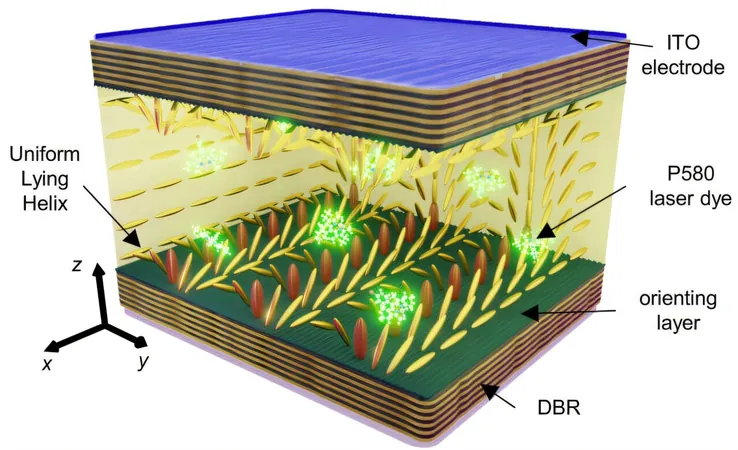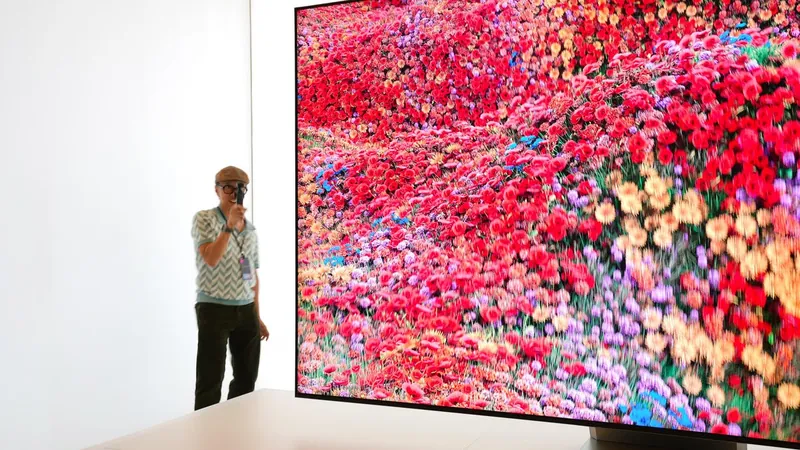
Revolutionary Platform Unleashes New Era of Tunable Photonic Crystals and Laser Tech
2025-07-01
Author: William
Groundbreaking Research on Photonic Crystals
In an exciting breakthrough, researchers have unveiled an innovative method that harnesses cholesteric liquid crystals within optical microcavities. This cutting-edge platform allows for the creation and dynamic adjustment of photonic crystals integrated with spin-orbit coupling (SOC) along with controlled laser emission, as documented in the journal Laser & Photonics Reviews.
Understanding the Helical Wonders of Liquid Crystals
The research team, hailing from the University of Warsaw, the Military University of Technology, and Université Clermont Auvergne, delved deep into the unique characteristics of cholesteric liquid crystals. These elongated molecules create a self-organized helical structure that operates as a one-dimensional periodic photonic lattice. Prof. Jacek Szczytko explains, 'The arrangement of these molecules forms layers that gradually twist, mimicking the structure of DNA or spiral pasta.' This structure's intriguing optical properties allow for the manipulation of light in groundbreaking ways.
Light Meets Mass: The Physics Behind the Magic
The utilization of optical microcavities plays a pivotal role, restraining light in one dimension and making photons behave as if they possess mass. This groundbreaking work enables researchers to manipulate properties typically related to matter while preserving the unique behavior of light.
A Collaborative Effort in Cutting-Edge Technology
Collaboration has been key in this project, with the Military University of Technology contributing to the fabrication of sophisticated optical microcavities. Prof. Wiktor Piecek emphasized the complexity of controlling liquid crystalline structures over large areas, a challenge their experienced team is well-equipped to handle.
Revolutionizing Photonic Crystal Technology
Current technologies for fabricating photonic crystals come with significant limitations, often being complex and costly. However, this new method allows for self-organized structures with much greater areas, and the ability to dynamically manipulate light's band structure through electric fields. First author Marcin Muszyński notes, 'Our work addresses previous limitations, enabling real-time adjustments of the lattice's properties.'
Unlocking New Frontiers with Spin-Orbit Coupling
A remarkable feature of this research is the conceptual discovery of interband spin-orbit coupling (ISOC), driven by the tilting of molecular orientations within the helical structure. This discovery may pave the way for enhanced functionalities in photonic applications. Moreover, the integration of organic dyes within the liquid crystalline setup has led to observations of dual lasing states, showcasing the versatility of their system.
The Future of Photonics and Laser Technologies
With these developments, the researchers are poised to explore new applications in topological photonics and the next generation of laser technology. Prof. Szczytko concludes, 'These advancements signal exciting possibilities for merging SOC influences with photonic structures, opening alchemical doors to phenomena like topological phase transitions and complex feature fields.' Expect to see these tantalizing new technologies take center stage in the near future!









 Brasil (PT)
Brasil (PT)
 Canada (EN)
Canada (EN)
 Chile (ES)
Chile (ES)
 Česko (CS)
Česko (CS)
 대한민국 (KO)
대한민국 (KO)
 España (ES)
España (ES)
 France (FR)
France (FR)
 Hong Kong (EN)
Hong Kong (EN)
 Italia (IT)
Italia (IT)
 日本 (JA)
日本 (JA)
 Magyarország (HU)
Magyarország (HU)
 Norge (NO)
Norge (NO)
 Polska (PL)
Polska (PL)
 Schweiz (DE)
Schweiz (DE)
 Singapore (EN)
Singapore (EN)
 Sverige (SV)
Sverige (SV)
 Suomi (FI)
Suomi (FI)
 Türkiye (TR)
Türkiye (TR)
 الإمارات العربية المتحدة (AR)
الإمارات العربية المتحدة (AR)